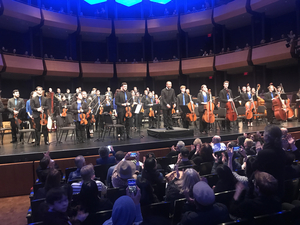Review: TŌN WITH TAN DUN! at Jazz At Lincoln Center

Hundreds of people go to the Time Warner Center (TWC) on Columbus Circle in New York City every day. They shop in the vertical mall, play with the cute statues in the lobby, dine at the fine dining establishments, or descend into the maelstrom of Whole Foods. But how many people know that a jewel in the cultural crown of the city is also a part of this frenetic scene? That the organization known as Jazz at Lincoln Center (even though the actual campus of Lincoln Center is about five blocks north, this is still a Lincoln Center constituent) is tucked away on a not-too-high floor of the TWC overlooking Columbus Circle, and hosts a roster of concerts of many musical genres?
It's a wonderful set of three concert venues. The Appel Room, Dizzy's Club, and the Frederick P. Rose Hall. It was in this, the largest of the three rooms, where The Orchestra Now (TŌN) gave a stunning performance of works by Stravinsky, Debussy, Bartok, and Tan Dun, (who was also the afternoon's conductor) on Sunday, December 15th 2019.
TŌN is a pre-professional, three year Master of Music degree program established at Bard College and created by Bard College president Leon Botstein (in partnership with professional musicians, teachers, and professional orchestra administrators). This unusually intensive preparation consists not only of orchestral studies but also studying aspects of a performance career not typically covered in other major schools of music. Although the orchestra members are all young in age, they have superb performance skills and when they emerge from their studies will be ready for any world-class orchestra or its administration.
A student gave an introduction to each of the works on the program. All four were personable and well-spoken, particularly Weiqiao Wu. Mr. Wu introduced the highlight of the concert, world-renowned composer and conductor (and recently appointed Dean of the Bard College Conservatory of Music) Tan Dun's Violin Concerto: Rhapsody and Fantasia 2009 (revised 2018). What might have been a somewhat knotty, impenetrable contemporary piece was made more accessible through Mr.Wu's explanation. The brilliant soloist Ms. Eldbjørg Hemsing brought the music to life, articulating each note with precision and richly dynamic expression. No mere walk in the park for the violinist, this highly rhythmic, complex work allowed each section of the orchestra to shine. The lovely, warm string sound was especially appealing. There was a large percussion battery that included Chinese gongs which bent the music into inimitable Eastern sounds. Mr. Dun's direction of the orchestra was clearly defined and dynamic. The orchestral response was instantaneous, which meant that all eyes were not only on the music, but on Mr. Dun as well. For the listener, this piece was imaginative, engaging, and downright fun to experience.
Fireworks Op.4 (1908) by Igor Stravinsky (1882-1971) was the brief concert opener. Initially a student composition, it came to the attention of Sergei Diaghilev, director of the Ballet Russe in Paris. This happy meeting paved the way for commissions which became Stravinsky's most famous ballet compositions such as The Firebird, The Rite of Spring, and Petrushka. Echoes of these scores can be heard in tiny quotes from Fireworks. The musicians tore into this exciting piece with great enthusiasm. It was a terrific start to the concert.
Another student work, the Rhapsody for Clarinet (1909-10) by Claude Debussy (1862-1918) featured TŌN clarinet soloist Viktor Tóth. Mr. Tóth's sensitive playing was at times somewhat melancholy and nostalgic. His ability to sustain long phrases on seemingly one breath without a lapse of pitch or support was astonishingly beautiful. At all times the orchestra provided a shimmering yet delicate background for the soloist.
The Miraculous Mandarin Suite Op.19 (1918-19 with many revisions through the years) by Hungarian composer Béla Bartók (1881-1945) was the final work of the day. This ballet tells a rather gruesome story and begins with an authoritative trombone solo and goes on to showcase all sections of the orchestra. There were several standout section soloists, which included the aforementioned trombone and some lovely oboe playing.
Upcoming performances by TŌN include a free concert at Symphony Space on Sunday February 16th at 4 pm, and other concerts led by Leon Botstein and Leonard Slatkin. For more information on the full season visit theorchestranow.org
Comments
.png)
|
.png)
|
Videos


